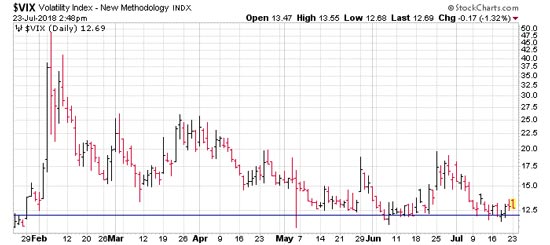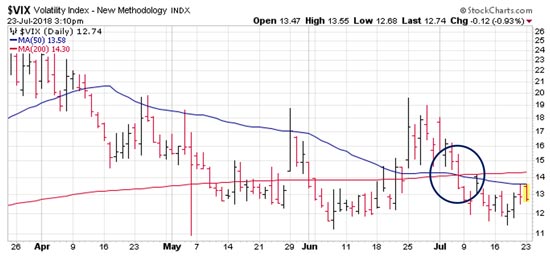Last week, I showed you we're heading into a seasonally weaker period for the market. Data from the past 20 years shows the market posting below-average returns during August.
And the rest of the year isn't much better. Add in your geopolitical headwind of choice - Russia, NATO, Brexit, tariffs, North Korea, anything - and you've got what could be a perfect bearish storm.
One of the factors the bears like to throw around is the low level of the CBOE Volatility Index (VIX), a measure of overall market fear.
It's the key to playing this situation.
[mmpazkzone name="in-story" network="9794" site="307044" id="137008" type="4"]
Volatility Is Struggling to Crack This Important Level
The VIX tends to move in the opposite direction of the market, so the recent decline in the VIX has been one reason for July being such a strong month.
But the decline has stalled of late, unable to push below the 12-point level. In fact, the VIX has had just two daily closes below 12 since the early-February spike.
A reversal of this stubborn support and subsequent move higher would be a concern for stocks and would only add to the bearish case.

But you know me - If there's an "if this happens, then this could happen" crowd at a party, I'm not in it.
GUTSY: This trader is betting it all he can show you how to turn $5,000 into AT LEAST $174,500. Click here...
Of course, there's a chance the market could correct. But let's take a closer look at the VIX to see what history tells us.
A few weeks ago, the VIX experienced a so-called "death cross" in which its 50-day moving average broke below the 200-day moving average.
For stocks, this normally would signal a new intermediate-term bearish trend, and that selling would likely increase.

But remember: The VIX moves counter to the market. Thus, a death cross that implies more downside for the VIX is actually bullish for the market.
Sounds good... but does the all-important data confirm my hunch?
Testing the daily data back to January 2000, I found 17 similar death crosses, which represent 0.4% of all trading days. The average move for the S&P 500 after these death crosses was unquestionably bullish, as the benchmark index gained an average of 1.5% over the subsequent three months.
Looking at the winning signals, the SPX averages returns of 5% after three months, about 70% of the time.
For the broad market, that's a solid return any time.
The real question, of course, is how you play the broad market.
For me, it's a question of perspective - are you more of a "glass half-full" or "glass half-empty" type of investor?
I believe in momentum - and the momentum right now is clearly bullish.
The major indexes are up between 3.2% and 4.4% this month. All are above their respective 50-day moving averages and all 50-days are pointing higher.
The risk-on trade - as demonstrated by small-cap and tech strength - is still intact. And the VIX hasn't made a definite move higher yet.
Yes, I acknowledge the bearish case. And it makes good sense to prepare for a bear run lower at any time; the markets will drop at some point. We'll be ready to swoop in when that happens.
But right now, the bear argument is based on an awful lot of "ifs."
If the risk-on trade fades... If the VIX reverses into an uptrend... If the technicals start breaking down... If trade wars intensify - if, if, if.
When and "if" one or more of those things happens, I'll adjust accordingly. But for now, I'm sticking with the bulls.
If you're a "glass half-full" type like me, play a call option in the September series, expiring Sept. 21.
Me? I'd look at an at-the-money index option on the S&P 500, like SPX Sept. 21, 2018 $2,800 calls (SPX180921C02800000), or on the small-cap Russell 2000, like the RUTW Sept. 21, 2018 $1,700 calls (RUTW180921P01700000).
There's an even cheaper way to do this, too.
If you want lower-priced options that "mimic" the S&P 500 and Russell 2000, play the SPDR S&P 500 Trust ETF (NYSE Arca: SPY), with a SPY Sept. 21, 2018 $280 call (SPY180921P00280000) and/or the iShares Russell 2000 ETF (NYSE Arca: IWM), with a IWM Sept. 21, 2018 $170 call (IWM180921C00170000).
Tell 'em the death cross made you do it!
The Gains on This One $10 Stock Alone Could Earn You Enough to Retire
A paradigm-shifting technology could disrupt every major industry, and one tiny company is at the center of it all.
It recently inked four major deals... BlackRock has snatched up 29 million shares... and its technology could be adopted by millions around the globe.
Follow Money Morning on Facebook, Twitter, and LinkedIn.
About the Author
Chris Johnson (“CJ”), a seasoned equity and options analyst with nearly 30 years of experience, is celebrated for his quantitative expertise in quantifying investors’ sentiment to navigate Wall Street with a deeply rooted technical and contrarian trading style.



